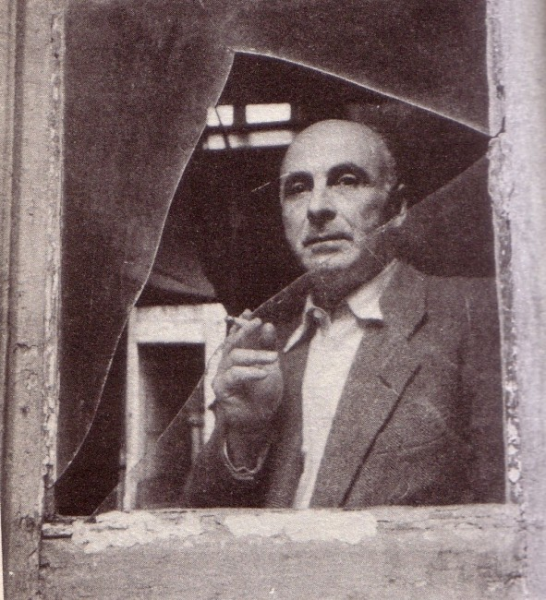Three pebbles
Or, the minimal materialisms of late modernism
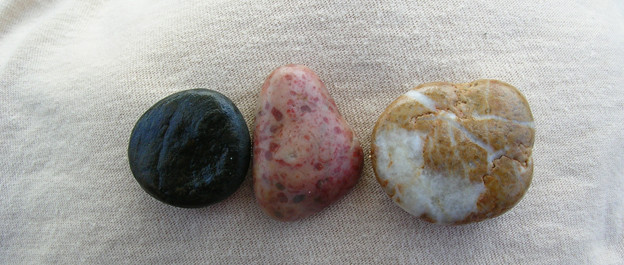
What is a pebble? Is it an object or a thing? A weapon or a tool? Is it naïve or is it sentimental? Is it a token of the real, or a fragment of ideology? Can you do more than skip it or hurl it or mark a grave with it? What is the pebble to poetry? Of what might the poem make it speak?
The Indian writer Amitav Ghosh has proposed that the novel as we have inherited it is a product of “the great derangement” of a fossil-fueled modernity that succeeded for three centuries in reducing nature to a more or less picturesque backdrop, while in the foreground we readers devoted ourselves to following the moral careers of the likes of Isabel Archer. The novel takes its modern form, according to Franco Moretti, via “the relocation of the unheard-of toward the background … while the everyday moves into the foreground,”[1] in what we might consider a form of narrative partitioning or enclosure. In the Anthropocene, however, figure and ground seem to change places as the natural world, which the Enlightenment had reduced to the status of inert matter, comes uncannily alive, asserting itself as the protagonist of narratives that bear the name of disaster. The realist novel, claims Ghosh, as a product of derangement, is peculiarly ill equipped to represent that derangement, or to make manifest to readers the conditions of a reality that is becoming less “realistic,” less plausible and believable, by the day.
Poetry, on the other hand, has not only had “an intimate relationship with climactic events” — Ghosh cites the freezing winter in which Milton conceived the “Universe of death” of the first books of Paradise Lost[2] — but it has long been at the forefront of resistance to the partitioning off of reality[3] — Ghosh cites Blake and Wordsworth, and one also thinks for example of John Clare’s invective against “Inclosure like a Buonaparte” and “lawless law’s enclosure” in poems like “Remembrance” and “The Mores.”[4] Could it be that the poem is better equipped than the novel, not to simply reverse the realist formula, but to put the unheard-of and the everyday in a tense and open relation, a relation disclosive of realism in the philosophical rather than the literary sense? To explore this question, I propose to think small — very small. I propose the pebble of modernist poetry.
The pebble is a thing, a fragmentary rock, a bit of nature that fits easily in the hand, yet which can scarcely serve effectively as any sort of weapon or simple tool. The pebble is an individual marked by its participation in and never more than partial emergence from multiplicity; a heap of pebbles is a figure for, or metonymic of, multiplicity itself.[5] To pick up a pebble is to separate it from its fellows, arbitrarily removing it from the multitude of other pebbles — on the beach, in a ravine, out of a quarry — among which it is invariably found. Each pebble is marked by its never more than partial emergence from something larger: rounded, worn, unimaginably old, each the result, if Francis Ponge is to be believed, of “scission from the same enormous grandfather,” the primeval “hero” of the earth itself, a “fabulous body” that, “having been liberated from Limbo … is nowhere to be found.” In Ponge’s poetic cosmogony, “The Pebble,” which reaches “even further back than the Flood,” imagines “the baptism of a hero as big as the world, only to discover the gruesome mess of his deathbed.” This “deathbed” or “sacred skeleton” is “the gray chaos of the earth, our humble yet magnificent dwelling.” It stands under and apart from “the millions of infinitely small and ephemeral beings that dwell on it.” Human life “envies the indestructible stability of its stony habitation, [when] in reality it assists in the continuous disintegration of its environment. And this unity of action seems like life’s central drama: confusedly it suspects that its pedestal may fail it one day, yet it feels itself to be eternally regenerative.”[6]
For Ponge, “stone does not remake itself in nature. It is in reality the only thing that is constantly dying in it.” This blurred boundary between animation and inanimation, life and death, is anticipated by many of the other prose poems of Le parti pris des choses which perform the Surrealist reversal of the animate and the inanimate: the human beings are stiff, mechanical, and absurd, while the crates, oranges, and loaves of bread of which he writes assume a touching animated dignity. The innocuous pebble, as one of “the scattered and humiliated forms of stone that the world presents to our eyes,” hints at the capacity of stone — the paradoxical “deathbed” of life — to resist its disintegration. “Nowadays,” Ponge writes, “the dead hero gets confused with the chaos of the earth.”[7]
Three years later Ponge wrote “Introduction to the Pebble,” in which he describes, in Paul Bowles’s translation, his desire “to write a kind of De natura rerum” in which he will seek “infinite resources in the thickness of things, restored to us by the infinite resources in the semantic thickness of words!”[8] Such a task depends on the poet’s surrender of personality, on “his refusal to object to the taking over of his personality by things.”[9] Bowles here translates comme un mal not as “an evil” but as “to object,” creating a thoroughly Pongeian semantic pun on the object versus the thing. “Taking the side of things” means, as suggested in the “thing theory” of Bill Brown, to confront “the thingness of objects,” something that happens “when they stop working for us: when the drill breaks, when the car stalls, when the window gets filthy, when their flow within the circuits of production and distribution, consumption and exhibition, has been arrested, however momentarily. The story of objects asserting themselves as things, then, is the story of a changed relationship to the human subject and thus the story of how the thing really names less an object than a particular subject-object relation.”[10] “Thingness” designates the breakdown in our ordinary instrumental relationship to objects, an instantiation of chaos that predicates their possible agency or, as Ponge puts it in another poem, heroism: “They are heroes, that is to say beings whose existence alone is a work of art.”[11] Exposure to thingness suggests exposure to an ontological break — an interruption in an otherwise ideologically constituted discourse.
Many of the things Ponge sides with, particularly in his early work, are human-made or at any rate available to human consumption: a candle, a cigarette, an oyster, soap. They have a homely, timeless quality that would seem to align them with the things of Heidegger’s philosophy: a jug, a peasant’s shoes, a temple. All try to function in Heidegger’s philosophy as ontological interventions in a world that has forgotten the question of Being, gesturing toward the lost plentitude of the earth. But the pebble, as fragmentary hero and token of chaos, is unmarked by the pastoral nostalgia that stains the Heideggerian Ding. Ponge’s pebble enframes nothing; it is the determinate negation of a temple or a monument: it is a stone with no sermon in it. What surrounds it and distinguishes it in its pebbleness is what Ponge calls “a void in signification”: the pebble speaks, but it has nothing to say except that it exists, in a precarious unity metonymic of multiplicity itself. I am one of many, says even the most solitary of pebbles; its individuality is itself minimal, for only an entirely arbitrary distinction in space and time distinguishes one pebble from its fellows.
Unlike Heidegger’s things, or for that matter the modernist fragments shored against Eliotic ruin,[12] the Pongeian pebble is an object without autonomy, a fragment of no reconstructable whole. The peculiarity of the pebble — its “thickness” (épaisseur) — derives from its resemblance to the Saussurean signifier, attached by the merest metonymy to whatever it signifies. It is the degree zero of individuality: the pebble is itself, separate and yet unalike from the other pebbles of its bed or field in no signifying way. Its bare ipseity — not quite an identity — that makes the pebble resemble a goose egg, a zero, a void. And trying to fill the void has its own dangers, as the last sentence of Ponge’s “The Pebble” warns, speaking in the voice of the speaker’s critics: “Trying to write a description of stone, he became entangled and turned into a stone himself.” Il s’empetra is the French for “he became entangled”; we lose in the English the pun on petra. In the face of the pebble’s refusal to signify, everybody must get stoned.
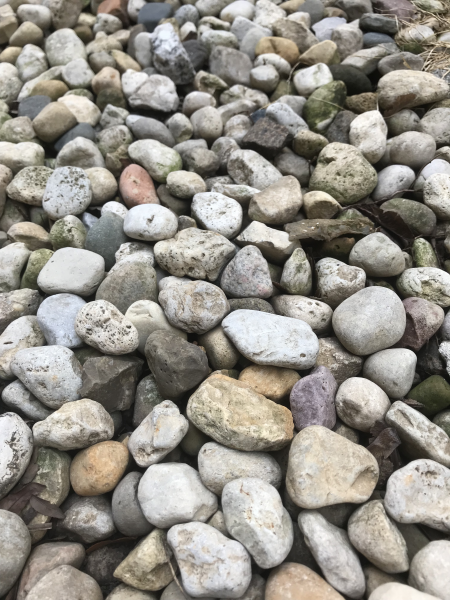
Pebbles in the author’s yard.
Pebbles do not signify in themselves. To make the pebble speak must mean, like Demosthenes trying to talk with his mouth full, to speak around and through the pebble. Only then have we a chance to be heard above the sound of the waves that continually grind the pebble down, denying it expression of its essence. The pebble as thing is neither fully absorbed into the subjectivity of the speaker’s utterance nor the object of his speech. It entangles the speaker’s tongue and infects the condition of speech itself. It is the burden of what cannot be said that is nonetheless part and parcel of the speaker’s saying. Ponge does not represent the pebble. He makes the pebble speak.
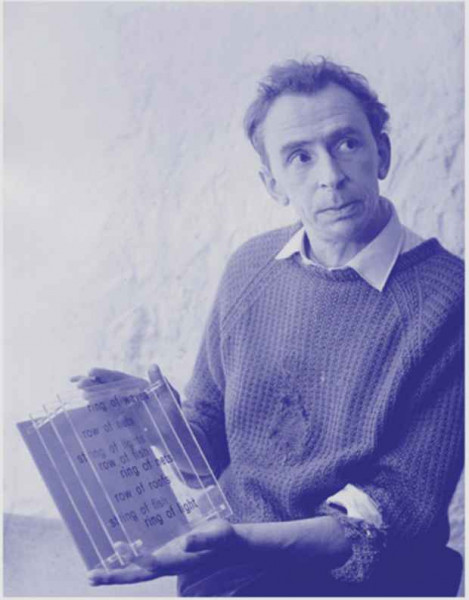
Ian Hamilton Finlay, 1925–2006.
If Ponge makes the pebble speak by risking sympathetic identification with it, his contemporary Ian Hamilton Finlay, the Scots poet, makes the pebble speak directly, albeit with a forked or redoubled tongue. In his “Detached Sentences on the Pebble,” Finlay seems to agree with Ponge when he claims that “A PEBBLE is a crumb of the Ancient Geology.” But he puts the pebble’s naturalness, or rather the supposed value of its nature, into question with another detached sentence: “The place of THE PEBBLE in modern aesthetics is that of Natural Man in the philosophy of J-J Rousseau.” Finlay refuses to concede the “lowly” or “untutored” pebble a voice of its own; for a neoclassical poet like Finlay, nature can hardly suffice as an end in itself. The pebble, he writes, “is foolishly preferred to the stout-hearted Cube and all the family of deliberate Forms expressive of the will.”[13] Willed to speak, his pebbles are unnatural. “A PEBBLE,” Finlay declares, “is a form of perfect vacuity, as a wild-flower is of modesty.” Whereas Ponge approaches the “void in signification” that surrounds the pebble obliquely, Finlay tackles it head on.
 Title page of Unnatural Pebbles.
Title page of Unnatural Pebbles.
Finlay’s “Detached Sentences on the Pebble” form a sort of conclusion or coda to the 1981 exhibition catalog Unnatural Pebbles, the body of which juxtaposes images of inscribed pebbles and stones with epigraphs from assorted classical and modern authors, with an emphasis on the Presocratics. In addition to these epigraphs, each pebble itself has been inscribed with a word or words: these pebbles are also petroglyphs. The pebble’s word is multiplied, put into strange dissociative syntax with itself, not only by the presence of the epigraphs but by Finlay’s use of a curving character he calls “The Sign of the Wave” that signifies the reversibility of the letters. “N\UDA,” for example, reverses itself into “U\NDA.” The intimate juxtaposition of nude and wave evokes the famous image of Venus on the half shell, and perhaps by extension the Venus of the invocation to Lucretius’s On the Nature of Things, in which the Goddess of Love represents the fundamental principle of Lucretian physics, the fall and swerve of atoms which, in combining with each other, make up the universe. The quote on the facing page, attributed to the Greek poet Xenophanes, asserts: “The mighty sea is father of clouds and of winds and of rivers.” Curving and feminine, the nude and the wave are implicitly the mother of these phenomena, a gentler incarnation of the “blind and breathless forces” that shaped the pebble in the first place.
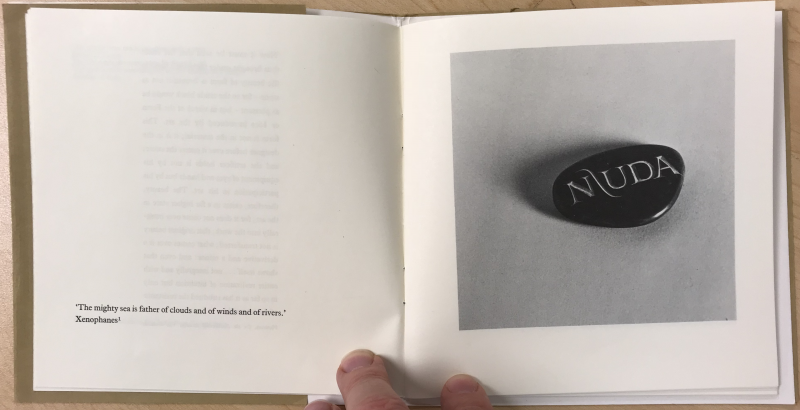
Finlay’s unnatural pebbles are a variation on the “heroic emblems” and one-word poems that began to preoccupy him in the mid-1960s, following what he described in a 1963 letter to Pierre Garnier as a “crisis in syntax”: “[T]he syntax I had been using, the movement of language in me, at a physical level, was no longer there — so it had to be replaced with something else, with a syntax and movement that would be true to the new feeling (which existed in only the vaguest way, since I had, then, no form for it.”[14] The unnatural pebbles and their accompanying detached sentences are a means of pursuing the new feeling via a kind of radical parataxis born of Finlay’s rejection of consecutive sentences, of which Finlay wrote, “Consecutive sentences are the beginning of the secular.”[15] “Secular,” for Finlay, means something very like William Blake’s “single vision,” to be militantly opposed by the fierce poetic piety expressed by Little Sparta’s notorious emblem of the lyre as Oerlikon gun.
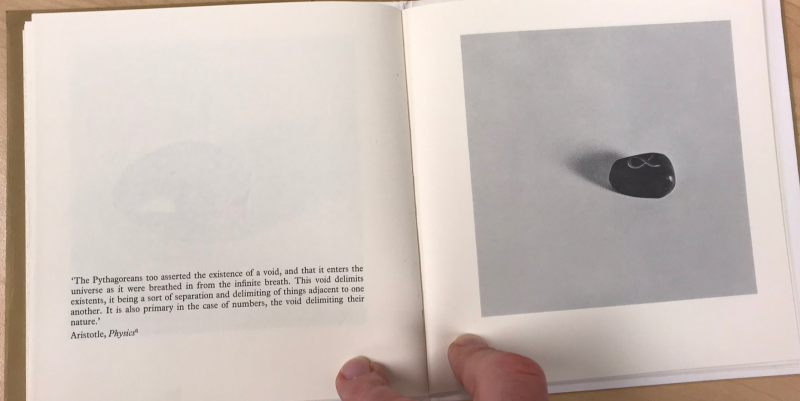
No single pebble is more expressive of this nonsecular parataxis than the pebble marked with no word but an ampersand, accompanied by a quotation from Aristotle’s Physics that asserts the Pythagorean claim of “the existence of a void, and that it enters the universe as it were breathed from the infinite breath. This void delimits existents, it being a sort of separation and delimiting of things adjacent to one another. It is also primary in the case of numbers, the void delimiting their nature.”[16] Itself meaningless, the void is nevertheless the ground for signification in its most fundamental and basic form: the count. To number is to name; the void puts us on the way to language. The pebble itself then signifies less the count of any particular thing than the count itself: it is the pebble of Finlay’s paratactic praxis, of one and one and one and one. Finlay’s ampersand pebble represents the degree zero of syntax, a metonym for metonymy, if not for the process of language itself.
Ponge locates what is “vitally, even dangerously alive”[17] in our desire to imitate the only apparent changelessness of stone: an ideology derived from an ontology of stone can lead only to petrification. For Finlay too, danger lies in an unthinking and superficial reverence for nature — for what Stephen Bann describes as “the weak, insidious rationalizing which commonly passes for thought.”[18] Finlay’s unnatural pebbles are weapons, just as his famous garden of Little Sparta is construed not as a retreat but as an attack. “PEBBLES are, it may be, reformed,” he remarks, “but they have a long and warlike history.”[19] Like Finlay’s heroic emblem of a Heraclitean aircraft carrier, the unnatural pebbles offer what Bann describes as “instances of an ‘undifferentiated state’ of language and of a ‘poetic cosmology.’”[20] They are emblems of a pre-Socratic (or in Finlay’s awkward coinage, “neopresocratic”) understanding of the atom, while the emblem of the nuclear-powered carrier “embodies in intimate and terrifying conjunction the power released by the splitting of the atom.”[21] The danger, Finlay seems to suggest, is not in nuclear technology per se but in the unthought-through suspension of the elements, which as Stephen Bann writes “bracket off the codes of warfare — the epic, the chivalric and indeed the romantic view of sea-faring being radically foreclosed in the elemental heroism of the nuclear confrontation.”[22] “Elemental heroism” — the agency of matter, of which the pebble is a fragmentary reminder — will not be contained by narrative “codes of warfare” that depend on the stability of the ground on which any fighting might take place. Finlay’s emblem draws our attention to what we might call the elemental rift: the unbridged gap in modern thought between the classical quadrivium of fire, earth, air, and water, and the atomic elements of the Trinity Test.[23]
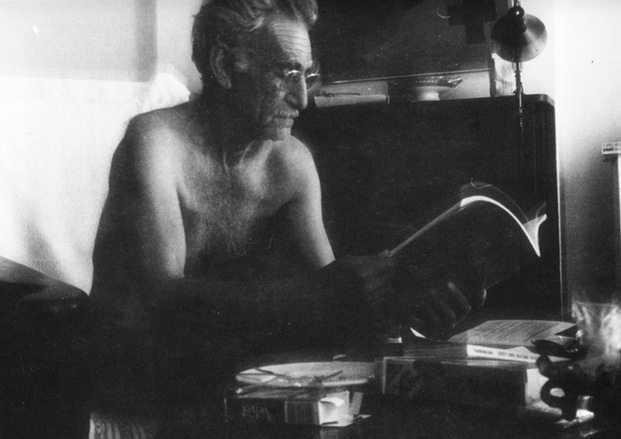
George Oppen. Image from Ironwood 26 (1985).
Let me conclude with a last pebble, a pebble from what Rob Halpern has called the geological imagination of George Oppen, for whom the indistinction of matter churned by socially blind action signifies terror, specifically the terror of total war. The postwar Oppen was intensely disturbed by the sleeping giant of a materiality that the dialectical materialism of the 1930s could not grasp, now awakened and incarnated as a deathly capacity that he came to identify in “Time of the Missile” as the “stone chain reaction.”[24] Halpern summarizes this move of Oppen’s succinctly as “objectivist realism,” a historicized and therefore ecopoetic counter to the ahistorical tendencies of the speculative realism associated with the likes of Quentin Meillassoux.[25] Committed as Oppen’s realism is to “an encounter with the thing in the present,” his “metaphysical vertigo”[26] is as insistently physical as the shock administered to the mind of Henry David Thoreau atop Mount Ktaadan: “Think of our life in nature, — daily to be shown matter, to come in contact with it, — rocks, trees, wind on our cheeks! the solid earth! the actual world! the common sense! Contact! Contact! Who are we? where are we?”[27] “To a body anything can happen, / Like a brick,” Oppen writes in “Blood from the Stone”; “Too obvious to say. / But all horror came from it.”[28]
Explicating these poems in a 1959 letter, Oppen writes, “The universe is stone, but we are not.” “Time and the Missile,” he writes, “is a poem of hatred of the ‘Stone universe’ and of love for ourselves and Linda — and all we have made of the universe by looking at it,” adding, “we didn’t make the atom we are made of, but all the rest is subjective.”[29] Trapped in a world he never made, Oppen pins his hopes on the subject’s ability to grasp matter with his subjective perceptions. “Is the stone,” asks Halpern in an earlier version of his essay, “a metonymic extension of the atom’s zero-degree materiality, or is it an allegorization or humanization of it? Where does one end and the other begin?”[30] It is precisely the indeterminacy of Halpern’s question that opens the path to the pebble in a crucial passage from section 26 of “Of Being Numerous”:
The power of the mind, the
Power and weight
Of the mind which
Is not enough, it is nothing
And does nothing
Against the natural world,
Behemoth, white whale, beast
They will say and less than beast,
The fatal rock
Which is the world —
O if the streets
Seem bright enough,
Fold within fold
Of residence …
Or see thru water
Clearly the pebbles
Of the beach
Thru the water, flowing
From the ripple, clear
As ever they have been
In all his later poetry Oppen follows, to cite his Heideggerian epigraph to This in Which, “the arduous path of appearance.”[31] In a 1972 letter to Michael Heller, he writes: “suppose, instead of an ‘instant archeology’ that imagines a personification of things already known, one imagines the first objects to become object to living consciousness — their force in that among sensations they emerged as objects — can we suppose, in the history of the Sacred, a greater moment ?”[32] The “stone universe,” a figure for the deadliness of ideology (“instant archeology”), is countered by the insistent clarity of Oppen’s image of the pebbles. The syntax of the passage, pivoting on a statement both ideological and ontological (“Which is the world —”), is emblematic, like the pebbles of Finlay and Ponge, of the complex byplay of their late modernist materialism with an emergent postmodern realism.
The Anthropocene is only the latest instantiation of the intimate and terrifying conjunction of atomic action with the fate of the earth. It seems to me that not the least value of recovering the midcentury poetic encounter with the uncanny vitalism of matter — here in the modest incarnation of the pebble — lies in the models such poetics may offer to our moment. Not only are we newly haunted by the specter of nuclear war, but we must grapple with a global situation in which seemingly miniscule and everyday actions — gassing up the car and driving to a literary conference, for instance — release carbon molecules into the atmosphere and tip us further into the situation described by Ponge’s phrase “the chaos of the earth.” We are fast approaching the moment in which neoclassical heroism — a concept declared dead and buried by diminished notions of “realism” that celebrate the unheroic and the everyday — may once again become a live option as we confront the dragon of our collective microscopic actions.
1. Franco Moretti, quoted in Amitav Ghosh, The Great Derangement: Climate Change and the Unthinkable (University of Chicago Press, 2016), 17.
2. Ghosh, The Great Derangement, 26.
3. Ghosh, The Great Derangement, 69.
4. John Clare, The Oxford Authors: John Clare, ed. Eric Robinson and David Powell (Oxford University Press, 1984), 260, 169.
5. Technically speaking, pebbles are fragments or “clasts” of sedimentary rock, which according to the Wentworth scale are smaller than cobbles (between 64 and 256 millimeters) but larger than granules or very fine gravel (2–4 millimeters — smaller than that, and we’re talking about sand). They are invariably the product of sea erosion: beach pebbles are produced by the action of the sea, whereas other pebbles are the product of ancient inland seas. For a fascinating discussion of real pebbles in their most poetic form, see Ian West and David Harvey’s “Chesil Beach — Pebbles.”
6. Francis Ponge, Partisan of Things, trans. Joshua Corey and Jean-Luc Garneau (Chicago: Kenning Editions, 2016), 57.
7. Ponge, Partisan of Things, 54.
8. Ponge, “Introduction to the Pebble,” trans. Paul Bowles, in The Random House Book of Twentieth-Century French Poetry, ed. Paul Auster (New York: Vintage Books, 1984), 327; italics in the original.
9. Ponge, “Introduction to the Pebble,” 325; italics in the original.
10. Bill Brown, “Thing Theory,” Critical Inquiry 28, no. 1 (Autumn 2001): 4.
11. Ponge, Partisan of Things, 20.
12. “These fragments I have shored against my ruins”: T. S. Eliot, The Waste Land.
13. Ian Hamilton Finlay, Unnatural Pebbles (Edinburgh: Graeme Murray Gallery, 1981), n.p., emphasis in original.
14. Yves Abrioux, Ian Hamilton Finlay: A Visual Primer, with introductory notes and commentary by Stephen Bann (London: Reaktion Books, 1985), 1992, 219, 220.
15. Finlay, “Detached Sentences on Metaphysics,” quoted in Abrioux, Ian Hamilton Finlay, 310n18.
16. Finlay, Unnatural Pebbles, n.p.
17. Ghosh, The Great Derangement, 3.
18. Stephen Bann, introduction to Abrioux, Ian Hamilton Finlay, 220.
19. Finlay, Unnatural Pebbles, n.p.
21. Abrioux, Ian Hamilton Finlay, 109.
23. I refer here to the first successful test of the atomic bomb in Los Alamos, New Mexico, on July 16, 1945. The operation was codenamed “Trinity” by J. Robert Oppenheimer, who later invoked the poetry of John Donne to explain how he chose that name, citing lines from “Hymne to God My God, in My Sicknesse” and also Holy Sonnet 14: “Batter my heart, three person’d God.” Richard Rhodes, The Making of the Atomic Bomb (New York: Simon and Schuster, 1986), 571–72.
24. George Oppen, New Collected Poems (Manchester, UK: Carcanet Press, 2003), 70.
25. Rob Halpern, “The Idiot Stone: George Oppen’s Geological Imagination; Or, Objectivist Realism as Ecopoetics,” in Ecopoetics: Essays in the Field, ed. Angela Hume and Gillian Osborne (Iowa City: University of Iowa Press, 2018), 46.
26. Halpern, “The Idiot Stone,” 57.
27. Henry David Thoreau, The Maine Woods.
28. Oppen, New Collected Poems, 53.
29. Oppen, The Selected Letters of George Oppen, ed. Rachel Blau DuPlessis (Durham, NC: Duke University Press, 1990), 29.
30. Halpern, “The Idiot Stone: George Oppen’s Geological Imagination,” unpublished talk, February 23, 2013.
31. The epigraph from Heidegger appears in Oppen, New Collected Poems, 92.
32. Oppen, The Selected Letters, 248, italics in the original.

